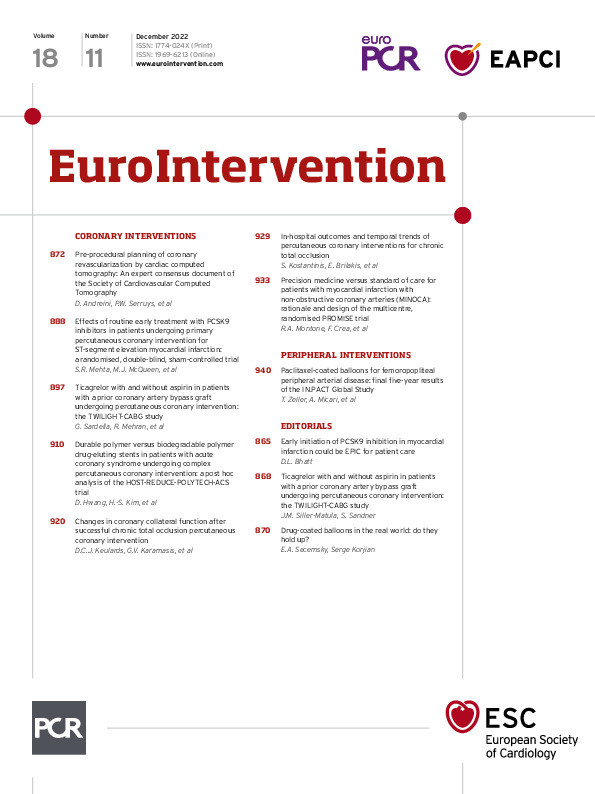A short dual antiplatelet therapy (DAPT) duration with a subsequent switch to single antiplatelet therapy (SAPT) or de-escalation to a less potent P2Y12 inhibitor has emerged as an effective treatment option in patients at high bleeding risk (HBR)123, especially in a multimorbid ageing population with cardiovascular disease.
Whereas several randomised clinical trials (RCT) have investigated different antiplatelet strategies with P2Y12 inhibitors after percutaneous coronary intervention (PCI) of native coronary vessels in patients without prior coronary artery bypass (CABG) surgery3, there is a considerable lack of evidence in patients after CABG surgery and those undergoing PCI after prior CABG. A recent meta-analysis of 4 RCT including 1,316 patients showed that 1-year DAPT with aspirin and ticagrelor after CABG surgery was associated with 49% decreased odds of saphenous vein graft failure. However, this came at the cost of a 3-fold increased risk of type 2, 3, or 5 bleeding events, according to the definition by the Bleeding Academic Research Consortium (BARC), compared with aspirin SAPT4. The only RCT examining ticagrelor monotherapy after CABG did not show a benefit in clinical outcomes5.
In this issue of EuroIntervention, Sardella and colleagues6 present the results of a post hoc analysis of the TWILIGHT (Ticagrelor With Aspirin or Alone in High-Risk Patients After Coronary Intervention) trial among patients with and without a history of CABG (TWILIGHT-CABG). The TWILIGHT trial compared the efficacy and safety of 2 antiplatelet strategies: each patient was treated with ticagrelor plus aspirin for 3 months, with subsequent randomisation to ticagrelor plus placebo or ticagrelor plus aspirin for an additional 12 months. Overall, 6,531 patients undergoing PCI were included in this analysis, of whom 703 (11%) had prior CABG. Patients with prior CABG were older, more frequently male and white, had more comorbidities, a higher ischaemic and bleeding risk burden, and lower medication adherence than those without prior CABG.
The TWILIGHT-CABG study6 gives us an important glimpse into the efficacy and safety of SAPT with ticagrelor after a short course of DAPT in a prior CABG population undergoing PCI. In order to be included in the TWILIGHT trial, patients had to present with clinical or angiographic criteria for high ischaemic or bleeding risk. When looking at baseline characteristics, the majority of patients with prior CABG were at high risk for both ischaemic and bleeding events: the average age was 67 years, diabetes mellitus was present in 47%, chronic kidney disease in 27%, previous PCI in 57%, peripheral arterial disease in 14%, multivessel CAD in 88%, complex PCI in 51%, anaemia in 23%, a history of major bleeding in 2%, and femoral access use in 75%. Considering the high-risk characteristics of this population, the study underscores the benefits of SAPT with ticagrelor in patients with prior CABG undergoing PCI: ticagrelor SAPT significantly decreased the risk of BARC type 2, 3, or 5 bleeding events (absolute risk difference [ARD] −4.7%) without an increase in ischaemic adverse events. This translates into a number needed to treat (NNT) of 21 to prevent 1 clinically important bleeding event. Whereas the direction of the effect on bleeding risk reduction under SAPT with ticagrelor did not differ between patients with and without prior CABG, the magnitude of the effect was greater in patients with versus without prior CABG (hazard ratio 0.50 vs 0.57, respectively). This analysis therefore adds important insights regarding the interaction between the baseline risk for ischaemia and bleeding and PCI complexity, and confirms previous observations that HBR patients benefit from short-term DAPT even after complex PCI78.
It should be mentioned that the findings of the TWILIGHT-CABG study6 cannot be applied to patients with ST-segment elevation myocardial infarction, cardiogenic shock, prior stroke or treatment with oral anticoagulation. Information on the proportion of patients fulfilling the bleeding risk criteria according to the Academic Research Consortium High Bleeding Risk (ARC-HBR) score and the time frame from CABG surgery to PCI may have proven useful.
In conclusion, the TWILIGHT-CABG study reassures physicians that a switch from DAPT to SAPT with the potent P2Y12 inhibitor ticagrelor is effective in preventing ischaemic events and safer with regard to major bleeding events as compared to a standard DAPT regimen in high-risk patients with prior CABG undergoing PCI.
Conflict of interest statement
J. M. Siller-Matula received speaker or consultant fees from Chiesi, Biosensors, Boston Scientific, P&F, Böhringer Ingelheim and Daiichi Sankyo during the last two years, not related to the submitted work. S. Sandner has no conflicts of interest to declare.

